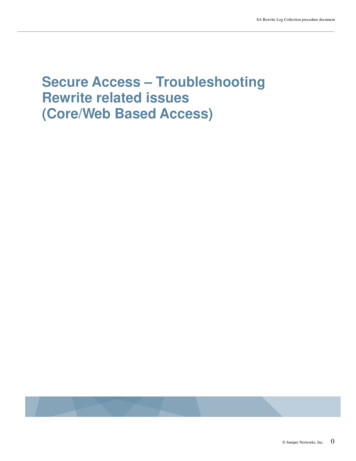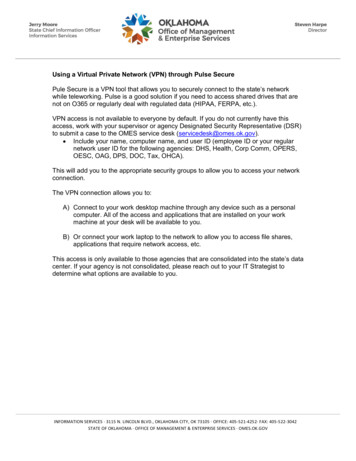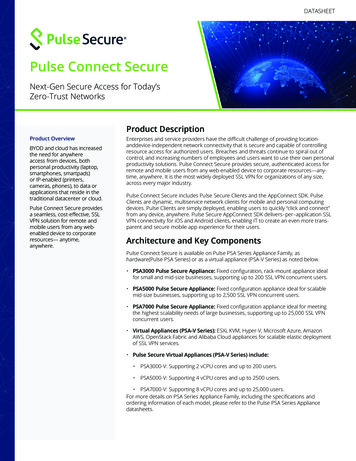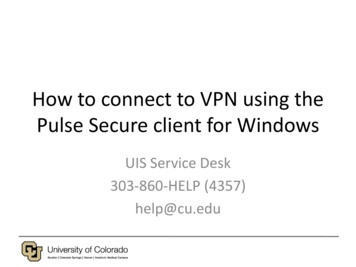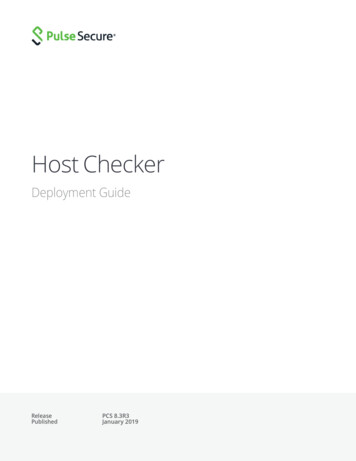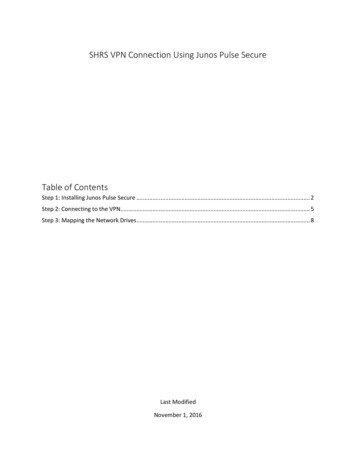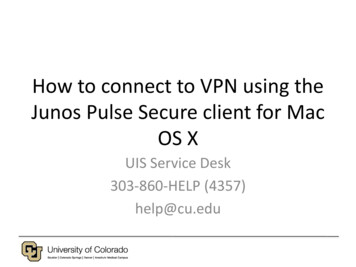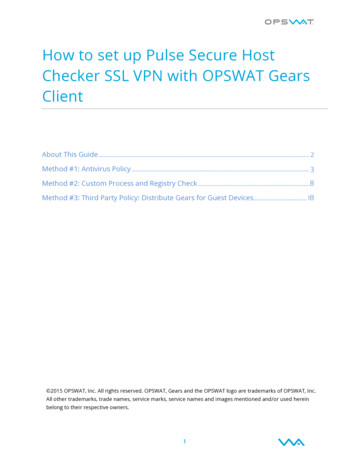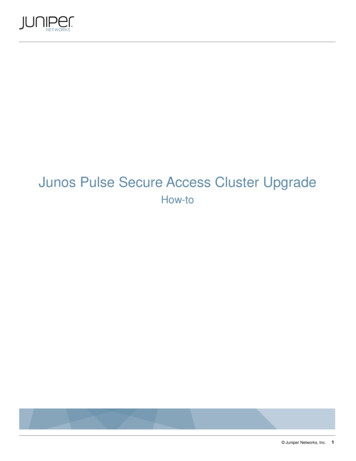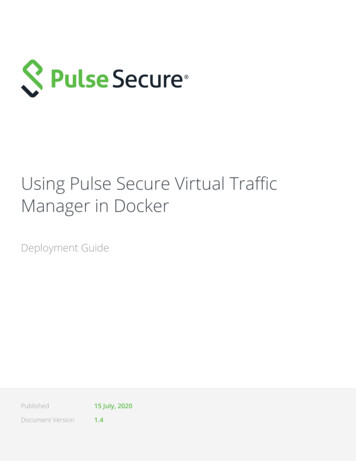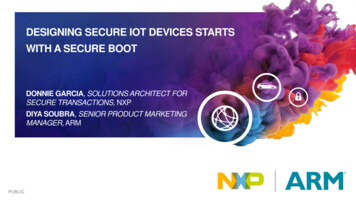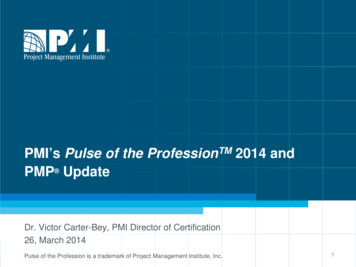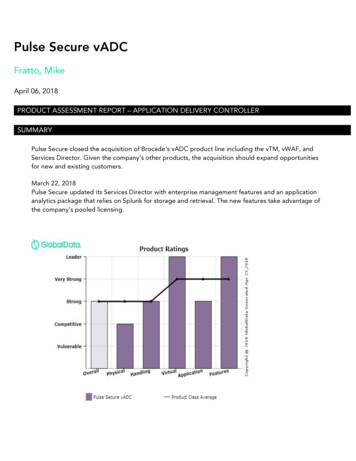
Transcription
Pulse Secure vADCFratto, MikeApril 06, 2018PRODUCT ASSESSMENT REPORT – APPLICATION DELIVERY CONTROLLERSUMMARYPulse Secure closed the acquisition of Brocade's vADC product line including the vTM, vWAF, andServices Director. Given the company's other products, the acquisition should expand opportunitiesfor new and existing customers.March 22, 2018Pulse Secure updated its Services Director with enterprise management features and an applicationanalytics package that relies on Splunk for storage and retrieval. The new features take advantage ofthe company's pooled licensing.
WHAT’S NEW August 1, 2017: Pulse Secure completed its acquisition of Brocade's vADC assets. Branding hasbeen updated and product naming is unchanged. March 21, 2018: Services Director 18.1, adds application analytics providing actionable insightsinto the behavior of applications across virtual and cloud platforms.PRODUCT OVERVIEWProduct NameVirtual Traffic ManagerDescriptionVirtual Traffic Manager (vTM) is a software-only ADC, which comes in Advanced,Enterprise, and Developer editions as a virtual appliance, cloud image, or bare metalofferings. The vTM is part of Pulse Secure's larger vADC family suite, which includes thevirtual Web Application Firewall (vWAF) and the Services Director to support capacitybased licensing.Components Virtual Traffic Manager (vTM) Web Application Firewall (vWAF) Services DirectorESSENTIAL ANALYSISStrengthsLimitations Capacity-Based Licensing: Pulse Secure vTMoffers a capacity-based licensing allowing customersto check-out and check-in licenses on demandacross on-premises and cloud instances. Enterprisescan monitor license usage and shift capacity toworkloads as needed which prevents over-buyingand wasted revenue. Additional license capacity canbe added on demand. Sans Templates: The lack of preconfigured application templates can makeintegrating vTM into application deploymentworkflows more difficult, so customers usescripting to automate the deployment andconfiguration process. Versatile: Pulse Secure vTM is available on avariety of commodity hardware, hypervisors, andcloud service platforms, including AWS, Azure, andGoogle, making deployments extremely versatile. Scripted: Pulse Secure vTM includes TrafficScriptfor content-based routing and has Python/Javascripting extensions. vTM also supports RESTful APIfor integration with orchestration and managementtools. Bring Your Own Hardware: Pulse SecurevTM is software only, and customers have tosource their own hardware, or host on anexisting virtual or cloud platform. Additionalserver management and troubleshooting isrequired.
CURRENT PERSPECTIVEPulse Secure vTM is part of its vADC portfolio, which also includes the Services Director and vWAF,available in software, virtual appliance, or bare metal form factors. Pulse Secure vTM ships inDeveloper, Advanced, and Enterprise editions. The Enterprise edition includes features like webacceleration and web application firewall, Kerberos support, and FIPS 140-2 certification on top ofwhat the Advanced edition offers. The Developer edition is a full-featured version limited to 1Mbps. While vTM has had a rapid succession of owners that will give some enterprises pause, PulseSecure has had a rapid return to pre-acquisition revenue, and the company has fully integrated vTMinto its portfolio and channel strategy, and continues to execute its roadmap.Integration features such as TrafficScript for on-device scripting and a RESTful API for configurationmanagement and control make vTM easy to adapt to most environments. TrafficScript can be usedto influence the load balancing algorithms allowing customers to address bespoke applicationdelivery issues without waiting on the vendor feature roadmap. The vTM currently doesn't supportapplication templates, but they are on the roadmap for H1 2018. Pulse Secure's analytics package,part of the Services Director 18.1 update, is similar in scope to application analytics from other ADCvendors like Citrix and F5 and brings it on par with those competitors. However, Pulse Secure'scurrent reliance on an existing Splunk infrastructure for the analytics application is a potentialhurdle, one the channel may struggle to cross. Pulse Secure's application analytics focuses on easeof use for enterprise IT and offers readily understandable graphic depictions of applicationperformance and allows IT to drill into particular segments to gain deep detail and insight intoapplication performance. It's a good starting point for most organizations that don't have an APMsuite in place.Customers that want to run a hardware ADC need to supply and manage their own server hardware.Pulse Secure maintains a list of certified server platforms and provides bare metal installationimages, removing the need for customers to provide server OS management and maintenance. vTMis supported on a wide range of VM platforms such as Hyper-V, Linux KVM, OracleVM, VMware, andXen Server, and offers full integration with OpenStack. vTM also runs on a wide array of cloudservices such as Amazon Web Services, Google Cloud, Joyent, Microsoft Azure, Rackspace Cloud,RightScale, and VMware vCloud Air. This flexibility gives enterprises a wide variety of options forrunning the vTM either locally or in the public cloud, or both.Pulse Secure has a versatile capacity based licensing program, supporting both perpetual andsubscription licenses. Licenses can be checked in and out as needed and applied to any vTM.Subscription licenses also have the added benefit of including support and updates, while support isan additional charge for perpetual licenses. vTM can also be licensed on an hourly basis on AWS.Customers can avail themselves of additional cost benefits by the use of Services Director forlicensing.
QUICK TAKEEvent RatingCompetitive ImpactCopyright 2018 GlobalData.Generated:22 March 2018 Promote Automation: Pulse Secure is one of the first ADC vendors to offer an automatedmanagement system including flexible license management, which is a positive differentiator. Pursue MSPs: Service and managed service providers are adding to their software offerings, whichis a good fit for Pulse Secure. Pulse Secure should seek out more service providers. Demonstrate Performance: Competitors with hardware appliances will compete on havinghardware and software offerings which ease migration and performance concerns. Watch the Cloud: Pulse Secure has added support for Google Cloud and Microsoft Azure to itsalready long list of supported cloud providers. Flex Your Licenses: Pulse Secure offers a flexible set of licensing options for cloud and onpremises, and will likely continue with more flexibility which will be attractive to customers. No Hardware, No Problem: Don't let the lack of hardware appliances be a hurdle. Pulse Secureoffers bare metal support for a number of certified platforms and guidance on sizing, and thesoftware-only products enhance application mobility. Consider Licensing Options: Moving to consumption-based pricing for some or all of your ADCdeployments can help you better manage costs and match spend with revenue.
COMPETITIVE POSITIVES The additional analytics in Pulse Secure's new version of Services Director leverages data collectedfrom the vADCs, allowing IT teams to easily view application performance and drill into issues. Analytics data can be exported to external applications like Splunk or Logstash, and then retrievedfor analysis and presentation. Access to data export is controlled through a role-based access control system, limiting thepotential for data exfiltration by unauthorized administrators. Pulse Secure has a flexible license-management process in which licenses can be checked in andout as needs change over time. Services Director 18.1 brings centralized backup and restoration of vADC instances, centralizedadministrative authentication, and centralized log collection.EVENT SUMMARYMarch 21, 2018 -- Pulse Secure announced a new release of its virtual Application DeliveryController (vADC) Services Director, giving IT and security professionals detailed information aboutdata flows through each application and providing actionable insights into the behavior ofapplications across virtual and cloud platforms. Pulse Services Director 18.1 is available immediately.ANALYTICAL SUMMARYPerspective Positive on Pulse Secure's Services Director 18.1 release, because it shows that the company iskeeping pace with its new acquisition and continuing to expand the product capabilities in ways thatwill be attractive to enterprise buyers. Analytics is a feature enterprises want but struggle to attainbecause the capital and operational cost of application performance management can be quite highto justify when there are many competing IT budget demands.Vendor Importance Very high to Pulse Secure, because this is the company's first major release of the vADC product itacquired from Brocade and it has carried forward the existing product roadmap by addingproductive features and flexible capacity-based licensing. Pulse Secure continues to find synergiesbetween its vADC software and other parts of its business and it is actively bringing together itssales channel and offering promotions to customers to expand their use of its software.Market Impact Moderate on the ADC market, because while the enhancements to Services Director 18.1 addvalue to vADC customers, Pulse Secure must raise its awareness as an ADC vendor, not only with itsown customers from different product lines, but also new customers. Most of the leading ADCcompetitors already have analytics in their products and integration with external log collection andAPM systems, making Pulse Secure's analytics and data export a necessary but somewhat limitedfirst attempt at analytics.
COMPETITIVE STRENGTHSCompetitive Positives The additional analytics capabilities in Pulse Secure's new version of Services Director leveragedata collected from the vADCs, and allows IT teams to view application performance and drill intoissues easily. The company focused on presenting visuals that show application health at variouspoints and allows IT to find problems segments and address them. Analytics data can be exported to external applications like Splunk or Logstash, and then retrievedfor analysis and presentation, allowing enterprises to use their existing log collection infrastructuresto capture data. With centralized collection, enterprise IT can also combine data for its own reports. Access to data export is controlled through a role-based access control system limiting thepotential for data exfiltration by unauthorized administrators. The role based access control ensuresthat potentially sensitive data is handled only by authorized personnel and will assist in datacompliance audits. Pulse Secure has a flexible license-management process in which licenses can be checked in andout as demand changes over time. Enterprise needs do change over time, and the ability to managelicenses from a pool maximizes flexibility. Services Director 18.1 brings centralized back-up and restoration of vADC instances, centralizedadministrative authentication, and centralized log collection, all of which ease operational overhead,particularly as the size of a deployment grows over time.COMPETITIVE WEAKNESSESCompetitive Concerns Pulse Secure has not made Services Director 18.1 available for cloud service providers, limiting itsimpact for that increasingly important route to market. Service providers of all types are looking toadd more capabilities to their software portfolio, and managed services is proving to be a goodroute to market for hardware and software networking vendors. While SPs talk about multi-vendor,the fact is that the first vendor in typically has the advantage. Pulse Secure doesn't offer a Splunk application for data analytics, which may be a hurdle forSplunk customers that want to centralize reporting and analysis. Similarly, some Splunk customershave centralized both collection and analysis on Splunk, and forcing them to a separate softwarepackage may be a hurdle.
BUYERS ACTIONS Competitors can point to the current requirement of a Splunk deployment to retrieve stored datafor analysis and an additional hurdle to successful deployment. Current Splunk customers may haveto augment their Splunk licensing to accommodate the additional data. Non-Splunk customers willhave to acquire the software. Pulse Secure can export data in a JSON format but the company has only developed formalsupport for Splunk and Logstash. It needs to add to its roadmap formal support for other logcollection products and projects. This is necessary to counter claims that the current product willremain limited to a few log collectors. This is particularly true for deals that have no ADCs deployedor are considering switching. ADC competitors should evaluate Pulse Secure's capacity-based licensing, which is highly flexibleand allows enterprise IT to dynamically move license entitlement to where it is needed. Enterprisesare used to on-demand capacity and it factors into buying decisionsANALYTICAL PERSPECTIVEEnterprise IT is always looking for ways to extract more value out of existing infrastructures, and acontinual blind spot is application performance management (APM). APM systems tend to beexpensive to acquire the software and underlying software infrastructure, and then they take expertmanagement to maintain. These additional costs become a barrier to alternatives to performancemanagement, such as reports from network performance management, over-provisioning of serverhardware, or simply waiting for users to complain about slow applications. Because ADCs sit in theapplication path, they are a viable option for application performance data collection and analysisusing existing deployed products.Pulse Secure's application analytics focuses on ease of use for enterprise IT and offers readilyunderstandable graphic depictions of application performance and allows IT to drill into particularsegments to gain deep detail and insight into application performance. It's a good starting point formost organizations that don't have an APM suite in place.In addition, Pulse Secure's capacity pool licensing allows enterprises to consume the software at thepoints in the network and the scale that it requires. Licenses can be checked in and checked outmaking it easy for enterprise to tailor the analytics collection as it needs to as demands change. Italso offers a low cost way for enterprises to get started.
METRICSVENDORProduct Family :Pulse Secure vTMList Price (low to High): 5,500 - 125,500CONNECTION HANDLING (per appliance or blade)RatingStrongThroughput10 Mbps - 145 Gbps (hardware dependent)L4 Connections per second10 Mbps - 145 Gbps (hardware dependent)SSL Transactions Per Second using1,000 - 55,000 (1024 bit keys; hardware dependent)2Kb KeysSSL Bulk Encryption50 Gbps (hardware dependent)VIRTUAL MODELRatingLeaderNamePulse Secure Virtual Traffic ManagerHypervisorvSphere 5 & 6, XenServer 7, OracleVM 3, Linux, Hyper-V 2012& 2016, QEMU/KVMCloud ServicesAWS, Google Cloud, Rackspace, Joyent, RightScale, XeroxACS, IIJ, Microsoft Azure, VMware vCloud AirMinimum VM requirements(CPU, RAM, storage, NIC)Intel Xeon, AMD Opteron, 2 GB RAM, 16GB diskThroughput (range)10 Mbps - 80 Gbps (hardware dependent)
APPLICATION DELIVERYRatingStrongLoad BalancingMethods (list)Round robin, weighted round robin, random, least connections,weighted least connections, fastest response time, perceptiveServer esOn-board plication SpecificSupport (list)POP, IMAP, SIP, HTTP, HTTPS, FTP, SMTP, LDAP DNS, RTSP,UDP, TelnetIPv6 SupportYesFIPS 140-2 SSL(including level 1-4)FIPS 140-2 Level 1 is supported.
MANAGEMENT FEATURES AND ve/ActiveFailoverYesADC ClusteringYesActive SessionFailoverYesCan physical andvirtual appliancesbe clustered?YesCan physical andvirtual appliancesbe used in failover?YesCan licenses bemoved to/fromcloud instances?YesIntegration APIsPython, Java, REST, SOAPMulti-tenantYesAll materials Copyright 2018 GlobalData. Reproduction prohibited without express written consent. GlobalData logos are trademarks ofGlobalData. The Information and opinions contained herein have been based on information obtained from sources believed to be reliable,but such accuracy cannot be guaranteed. All views and analysis expressed are the opinions of GlobalData and all opinions expressed aresubject to change without notice. GlobalData does not make any financial or legal recommendations associated with any of its services,information, or analysis and reserves the right to change its opinions, analysis, and recommendations at any time based on new informationor revised analysis.GlobalData PLC,John Carpenter House,7 Carmelite Street,London,EC4Y 0AN, 44 (0) 207 936 6400
Enterprise, and Developer editions as a virtual appliance, cloud image, or bare metal offerings. The vTM is part of Pulse Secure's larger vADC family suite, which includes the . Splunk customers that want to centralize reporting and an
